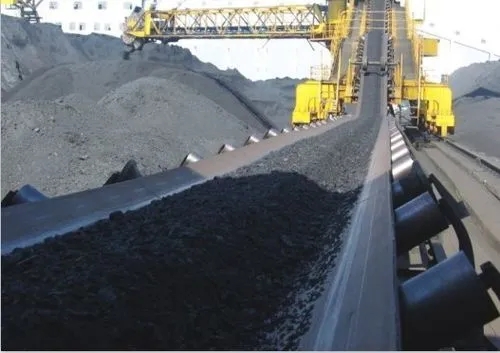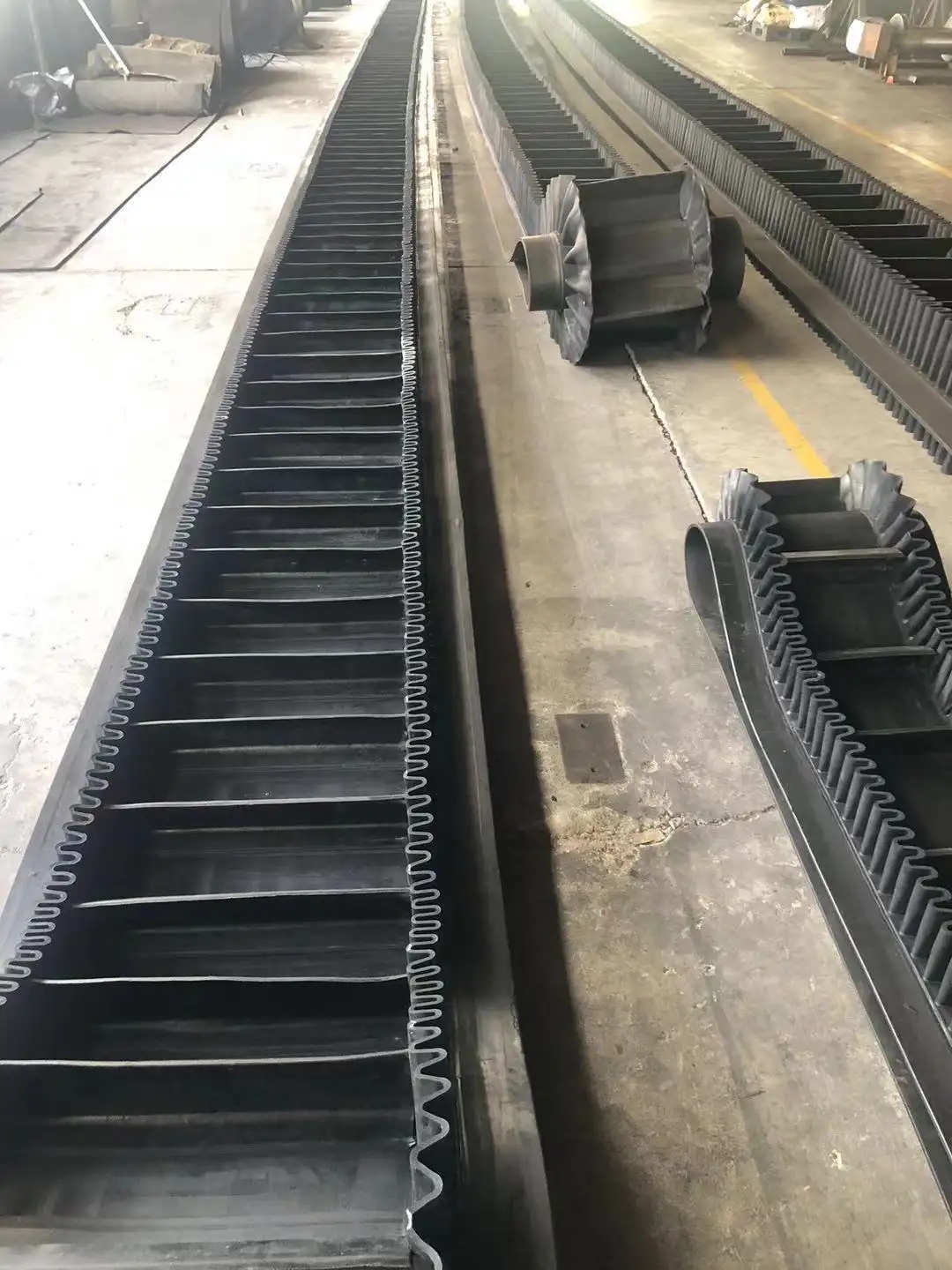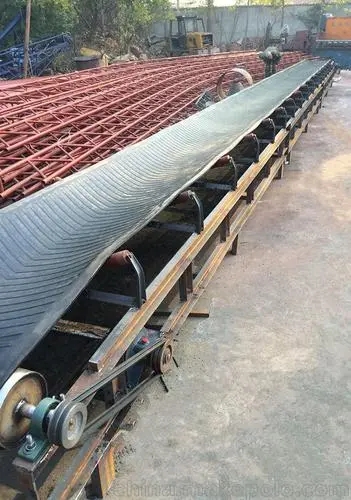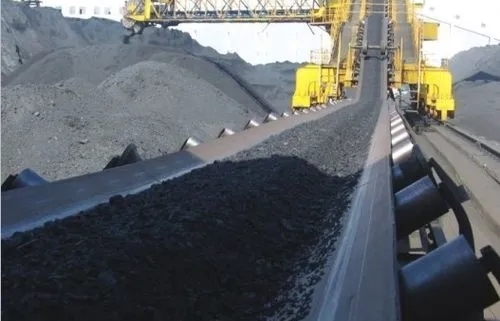What is safety protection device for the belt conveyor
Since the 1980s, with the construction and development of high yield and efficient mine, large volume, high efficiency of belt machine transportation mode has been widely used, belt conveyor has become the main tool of coal mine coal flow transportation in China, belt conveyor safety monitoring technology and automation technology has become an important content of coal mine production safety and automation technology.1. Relevant safety regulations of belt conveyor

rubber conveyor belts
Regulations to be transported by a roller-driven belt conveyor
(1) Flame-retardant conveyor belt must be used.
(2) There should be sufficient lighting in the roadway.
(3) Drive roller anti-skid protection, coal pile protection and anti-run deviation device must be installed.
(4) Temperature protection, smoke protection and automatic sprinkler device should be installed.
(5) The belt conveyor installed in the main transport roadway must also be installed:
① conveyor belt tension drop protection device and tear prevention device;
② nose and tail guard against personnel contact with drive and guide rollers.
(6) The belt conveyor used in inclined shaft shall be equipped with defensive reversal device and brake device shall be installed.
(7) Liquid coupling, it is strictly prohibited to use combustible transmission medium (speed-regulating hydraulic coupling is not subject to this limit).
(8) The bridge should be set across the belt conveyor in the belt conveyor roadway.
(9) Soft starting device should be added, and soft brake device should be equipped with lower belt conveyor.
2. Provisions on the safety protection device of the belt conveyor
According to the structural characteristics of the underground electromechanical transportation equipment and the different positions of the electrical equipment, good protective devices must be established to ensure the safety of the person and the equipment.
The following is mainly for the rotating part, the exposed part of the electrical equipment, and the location of the human transverse belt conveyor and the equipment room chamber made provisions.
(1) Protective guardrail shall be installed in all exposed rotating parts of exposed electrical equipment and equipment, as well as in any parts or places that may endanger personal safety.
(2) Where someone often crosses the belt conveyor, there should be a bridge, and the bridge should have handrails and railings.
(3) The equipment room chamber shall be equipped with necessary fire-fighting equipment. The chamber must be equipped with no less than 0.2 m3 sand box and yellow sand and more than 2 qualified fire extinguishers.
(4) The belt conveyor in the head within 20 m of the main roadway must be supported by non-combustible materials.
(5) The roadway using the belt conveyor hydraulic coupling shall be equipped with fire extinguishing equipment, and its quantity, specifications and storage location shall be determined in the mine disaster prevention and treatment plan.
(6) It is strictly prohibited to transport blasting materials with a belt conveyor.

rubber conveyor belt
3. Provisions for the belt conveyor braking device
Belt conveyor in the normal working state or fault state, according to different parking requirements, must take the necessary braking, and in the braking process of the belt conveyor braking device must be flexible and reliable, each part of the transmission mechanism, brake tile and contact area should meet the following provisions.
(1) The drive rod of the brake device is flexible and reliable, and the pin shaft is not loose or short of oil. There is no oil trace on the brake wheel surface, and the hydraulic system does not leak oil.
(2) Under loose condition, the brake tile clearance shall not be more than 2 mm; the brake, and the effective contact area shall not be less than 60%.
(3) The brake belt (brake tile lining belt) of the steel wire rope traction belt conveyor brake device is not broken, and the remaining wear thickness shall not be less than 3 mm. The trench mark depth of the brake wheel surface shall not be greater than 1.5 mm, and the total trench width shall not exceed 10% of the effective width of the brake wheel.

rubber conveyor belt protection
4. Safety protection device for the belt conveyor
1) deviation and protection device of conveyor belt
It is a common problem for belt conveyor to deviate in operation. The main harm of the conveyor belt deviation is: the early tear damage of the edge of the belt, the coal scattered along the belt can not operate normally, and the serious fire will be caused due to excessive friction.
The causes of the deviation are: the roller and the middle line of the conveyor belt are not vertical; the force of the conveyor belt joint is uneven; the loading is biased to one side (partial load); the manufacturing quality of the conveyor belt itself is not good, such as the core wire rope is uneven. Offdeviation may occur anywhere on the conveyor belt.
The protection methods are:
(1) Make the drum into an appropriate drum shape;
(2) Turn the two sides of the groove roller slightly forward to 2~3 angles;
(3) Equipped with a centering roller on the fixed conveyor;
(4) The inclined roller is used for the toilet disassembly and rope frame hanging conveyor;
(5) Improve the installation quality, make the fuselage into a straight line according to the prescribed requirements, the roller and roller and the vertical axis of the conveyor vertical, the conveyor belt joint is uniform, etc.
In order to prevent the possible accidents caused by the belt type deviation, the belt deviation protection monitoring device must also be installed along the conveyor, which can be automatically stopped when there is a continuous deviation.
At present, most belt conveyors mostly the stroke switch anti-deviation protection device. It consists of an anti-bias sensor and a control box. When the conveyor belt deviates, the conveyor belt pushes the vertical roll to the outside to contact the sensor dynamic contact and the fixed contact, and control the belt conveyor power shutdown through the control box. Generally, the rolling travel switch with the handle is used to monitor the deviation of the conveyor belt.
2) Drive roller skid and monitoring and protection device
The skid caused reduced friction traction of the drum, overloading or stuck strap. The friction traction force is reduced because the conveyor belt or drum is stained with mud, and the tension of the conveyor belt decreases.
If the drum skid is not corrected continuously, it can cause a major accident of conveyor belt fire. Conveyor belt fire will not only cause huge economic losses to mine production, but also seriously endanger the life safety of underground workers. Therefore, the prevention of belt machine skid and conveyor belt fire has been highly valued.”Coal Mine Safety Regulations” stipulates that the conveyor belt used by the underground belt conveyor must be the flame retardant conveyor belt, the non-metallic material parts of the belt conveyor roller and the rubber wrap roller, its flame retardant and anti-static resistance must also meet the requirements of the relevant regulations. However, the continuous skid of driving drum should also produce harmful smoke smoke pollution air, endangering the health and safety of underground workers. In order to prevent the belt conveyor drum skid and the safety accidents caused by other friction factors, the underground belt conveyor used must have the following safety monitoring and protection devices:
(1) Drive drum anti-skid protection and temperature protection monitoring device;
(2) Coal stacking protection and monitoring device at the unloading end;
(3) Anti-run deviation monitoring and protection device of the conveyor;
(4) Smoke protection and automatic sprinkler device in the conveyor transport roadway;
(5) The belt conveyor installed in the main transportation roadway must be installed: the conveyor belt tension drop protection device.
skidding, monitoring and protection devices include:
① tubular skid protection device. The tube skid protection generally mounthe sensor magnet on the side of the guide drum and bolted. The sensor is installed adjacent to the guide drum. If the conveyor belt breaks or slips during operation, the speed of the guide drum will change. When the speed of the guide roller as reflected by the sensor drops to the set value, the protection device sends a signal to stop the belt conveyor.
② roller type belt breaking and skid protection device. The device consists of a roller sensor and a control box. During normal operation, driven by the conveyor belt, the roller maintains a certain speed, and the protection device does not move. When the belt break skid occurs, the conveyor belt operation speed slows down or stops. When the roller speed reaches the set value, the protection device sends a signal to stop the belt conveyor.
3) Coal piling protection device
Coal piling protection device, also called coal level protection device. It is a device used to detect whether a coal bunker is full or whether the reprint point is piled up and blocked. When coal piling occurs, the coal piling protection device controls the belt conveyor shutdown. There are mainly two kinds of carbon pole type and offset type
(1) Carbon polar type coal reactor protection device is composed of coal reactor sensor and control box. The coal pile sensor (a cable or special coal level probe) is placed at a certain height of the coal bunker or reprint point as the fixed contact, and the coal is used as the moving contact. When the coal pile reaches a certain height in contact with the coal pile sensor, the control box will control the belt conveyor power shutdown of the belt conveyor.
(2) The offset type coal piling protection device is composed of the offset sensor and the control box. The yaw sensor is mounted on the coal pack tip or at the lap point of the two belt conveyors. There is a steel ball and a delay switch in the deflection sensor. When the suspended sensor is vertical, the steel ball presses on the delay switch. When the coal level rises to tilt the sensor over the action Angle, the steel ball rolls off, the switch delay action sends a signal, and the control box controls the belt conveyor. When the coal level drops, the sensor returns to the vertical state, and the steel ball presses the delay switch to make it be reset instantly.
4) Broken break and longitudinal tear protection device of wire core belt conveyor
Long distance conveyor belt has one joint every 100m, 2000m long conveyor belt has at least 40 joints, due to low belt joint quality, dynamic load and other use factors, so safety technical measures should be taken: ① to strengthen joint quality process management, strict operation procedures; ② uses joint quality nondestructive monitoring technology to ensure joint strength in traction operation; ③ installed on the conveyor to reduce the possible accident hazards caused by disconnection.
Steel rope core conveyor belt, because the transverse strength between the two steel rope is weak, in operation, if stuck by the blade, and continue to run, will cause the longitudinal separation of the conveyor belt. Longitudinal tear of the conveyor belt will not only cause equipment loss, but also will seriously affect the production. The solution is to install longitudinal tear monitoring and protection devices at the loading point.
The tear protection protection device is composed of tear protection sensor and control box. Anti-proof sensors are usually mounted in front of the coal feeder or below the upper conveyor a few meters from the loading point. The longitudinal tear protection device of DJS_BA type 1 conveyor belt is commonly used in coal mine. The function of the tear-proof protection device is to timely control the shutdown of the belt conveyor when the belt conveyor belt occurs to prevent the expansion of the tear accident.
When the conveyor belt where the longitudinal tear passes over the longitudinal tear sensor, the coal above the conveyor belt falls on the sensor along the longitudinal gap of the tear, and the conductive rubber plate is deformed and attached to the electrode printing board, closing the normally open contact, and controlling the conveyor shutdown through the control box. The disadvantage of this tear-proof protection device is that when the conveyor belt is torn vertically and the conveyor belt is free of coal, it cannot prevent the expansion of the conveyor belt tear accident.
The other tear-proof protection device consists of a winding hanging roller and a limit switch, installed in the bracket of the loading point. When the conveyor belt is punctured open by the sharp tool, the conveyor belt roller changes the position by inserting the sharp tool of the conveyor belt, thus driving the limit switch to stop the conveyor.

conveyor belt
However, the existing monitoring and protection devices can only stop the conveyor when a sharp blade penetrates a certain depth, so more complete longitudinal tear protection devices need to be developed.
5) Smoke temperature alarm and fire extinguishing system device
Smoke temperature alarm and fire extinguishing system device can continuously monitor the temperature and smoke changes of the mine belt conveyor system. When the temperature and dust concentration around the belt conveyor reach the set value, the alarm in the device will emit a sound and light alarm, and cut off and stop, sprinkling water and extinguishing the fire.
Smoke temperature alarm fire extinguishing system device is mainly composed of control box, sensor, acoustic and optical alarm and sprinkler device. The general smoke protection sensor is light-sensitive and gas-sensitive elements, which is generally installed in the roadway within 5 m of the lower air outlet of the nose unloading drum.
Temperature protection usually uses thermocouple components or thermistor as a temperature monitoring sensor, motion components (such as transmission drum) using the magnetic conductivity of the ferromagnetic material and temperature changes, using the magnetic induction pulse transmitter as a sensor, once the temperature is too high, the protection device action, the conveyor will stop running.
6) Safety protection device in inclined transportation
The belt conveyor used in the inclined shaft lane, in full load transportation, has a large downward thrust due to the dead weight separation of the material, which is easy to cause “reverse” and “flying speed” and other accidents. Shipping “reversal” is the upward belt conveyor, in the process of full load loading, if the power is cut off, can not effectively brake, will produce a reverse reversal of the accident. Lower transport “speed” is the conveyor in the downward transport, in constant speed operation is using the motor generator mode to control the speed, power off, the conveyor loses the electromagnetic balance torque of the motor, if no effective deceleration braking mode, will cause a serious accident of the conveyor high speed “speed”; therefore, effective protection device should be installed on the inclined transport conveyor:
Security reverse device and brake device must be installed, and reliable downhill brake protection device must be installed for lower belt conveyor. At present, there are several safety deceleration brake protection methods used in the lower transport belt conveyor:
(1) Using winding motor power braking, this way can only be used in the absence of explosion-proof requirements;
(2) Use hydraulic braking device to reduce the speed, and stop with mechanical brake gate at low speed;
(3) Use the hydraulic braking device to brake;
(4) Increase the heat dissipation capacity of the disc brake brake, so that the temperature does not exceed the specified value.
7) Fly-belt protection device
Flying belt protection is used on a sloping down belt conveyor. Its function is to capture the conveyor belt in time in the case of loss of control or the conveyor belt and drum skid after braking, to prevent the flying belt accident. The hydraulic flybelt trap is composed of a hydraulic system, a drum and a rubber wheel.
This flying belt trap is controlled by oil pressure, when the belt speed exceeds the rating; the control system opens the oil circuit valve, the rubber wheel drives the hydraulic pump to discharge the oil through the pipeline into the hydraulic cylinder, push the hydraulic cylinder piston to make the cylinder downward movement, the cylinder body to connect with the cylinder, thus pushing the drum downward movement. The rubber wheel is fixed, and the conveyor belt is pressed between the drum and the rubber wheel. Therefore, it increases the running resistance of the conveyor belt, reduces the running speed of the conveyor belt, and prevents the conveyor belt from running overspeed and flying belt accidents. When the conveyor belt speed drops to the rated speed, the control system closes the oil circuit valve. Under the action of the spring, the conveyor belt returns to a free straight line state from the pressure deformation state.
8) Protection device along the line
The function of the protection device along the line is not only to artificially stop the operation of the conveyor in any part of the belt conveyor, and to control the occurrence and expansion of the belt conveyor accidents in time.
① button-line protection device, namely, install an emergency stop button every 40~50 m, and be connected to the belt conveyor control system. Usually installed on the belt conveyor roadway crown help.
② pull line along the protection device, also known as along the emergency stop switch. It uses barbed wire or thin wire rope to control a small travel switch, connecting the travel switch to the belt conveyor control system. This protection is usually mounted on the side of the belt conveyor rack against the sidewalk.
9) Comprehensive protection and centralized control device
With the needs of coal production and the development of science and technology, China has developed a variety of belt conveyor comprehensive protection and centralized control devices.It is composed of various sensors and centralized console, can achieve low speed, overspeed, broken belt, longitudinal tear, coal pile, deviation, emergency stop, smoke, temperature and other protection, and can be sprinkling water cooling. It has the motor power, tape running speed, emergency stop switch action position, running deviation switch action position, the main motor temperature digital display function and all kinds of equipment working state and fault state display, can cooperate with CST soft start system, at the same time to the main motor, coal feeder and brake motor equipment control and protection.
KPTB_1 belt conveyor integrated protection monitor is a language type integrated protection device. It has both centralized control and stand-alone control operation modes. In the centralized control, it has the chain protection function, that is, when one unit is stopped, the belt conveyor supplying coal to it is in the chain shutdown, with the function of reverse coal flow delay sequence startup. Under manual control, the open and stop sensor can start the coal flow. Whether in centralized control mode or manual mode, the device has start start delay function, language warning function, fault stop protection function, fault display function, fault display function, fault language alarm function, fault self-locking and unlocking function, full line system status and position display function, full line contact and intercom function.
PZBJ belt conveyor can protect the scraper tilt caused by chain breaking.
In recent years, some domestic scientific research institutions and colleges and universities have done a lot of work in the safety protection and safety monitoring technology of mining belt conveyor, and developed many suitable for coal mine application, advanced technology conveyor safety monitoring devices, such as: “KJ9 mining economic belt conveyor monitoring system”, “DJB-II belt conveyor centralized control protection device”, “KJD type 2 mining computer belt conveyor monitoring device”, “KJ2002 belt conveyor computer explosion-proof electric control device”, etc. It has promoted the development of safety protection technology and monitoring technology of mining belt conveyor, and made contributions to the development of mine safety production and automation technology.


Thank you for the useful information. These are the common preventative maintenance checklist for conveyors like Low tension Inspection, Surface and belt edge wear, Drive bar and belt support Inspection, etc.
Thanks for your common , your share to other people is best approval for us